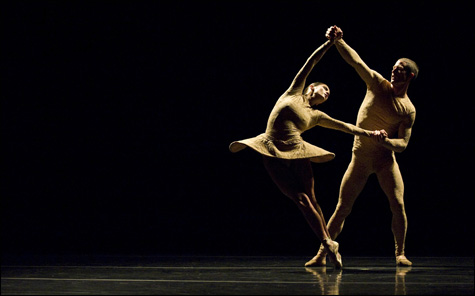
“AWWW, CUTE”: Itzak Galili’s Chameleon didn’t go much farther than that in its social commentary. |
Aspen Santa Fe Ballet’s program at Jacob’s Pillow last week sampled four choreographers while showing off the dynamic 11-member company. The dances, all made during the last decade, revealed some limitations of contemporary dance style.
You’d expect that access to every and any kind of technique would make for exciting dancing. That, of course, has been the assumption of contemporary dancemakers for decades, but the process has reached a kind of stasis that’s broken only by some exceptional choreographer. We get lots of moves, lots of surprises, beautiful bodies, but no serious challenges. The style functions fine with the audience, which knows it’s seeing something that’s more refined than a TV dance show but just as kicky.
Helen Pickett’s Petal, commissioned for Aspen Santa Fe and premiered last winter, was a stream of ballet-inflected duets and formations for four women in bright yellow swimsuits and pointe shoes and four men in blue muscle shirts and pants. The usual situations got played out: neatly structured choruses, duets that looked like struggles, a trio where two men manipulated a woman. During small encounters and formal movement displays, people would exit determinedly, as if they had important things to do off stage. They’d slip back in and begin some new phrase off to the side while something else was going on.
Pickett’s movement called attention to its balletic foundations with anti-balletic misalignments and feistiness, none more or less distinguished than the others. The dancers often looked as if they were wriggling out of voluminous, ill-designed garments.
Jorma Elo also tries to make unusual movement. His 1st Flash (2003), to Jean Sibelius’s super-romantic Violin Concerto, was a collection of energetic shapes and gestures. At the beginning, dancers rushed on stage, stopped, shook their hands violently, and went away. The whole dance goes in bursts like this. The dancers always seemed to be building up to a stop, or collecting energy to begin moving again from some scrunched or angular position.
There’s not much emotional or physical throughline to this spasmodic process. I seized gratefully on moments that bore some social nuance. Two women looped and relooped their arms around each other’s arms, finding tricky new spaces to cut through. They seemed to be involved in this game, and perhaps in each other, until a man ran over and cut between them. He shoved one of the women away and took over the loop game. None of them seemed fazed.
The Israeli choreographer Itzak Galili’s Chameleon (1998) purported to be about “the constant metamorphosis of femininity.” If so, it’s femininity narrowly defined. Five women in black bikinis with black net cover-ups sit in five green chairs and execute a long string of stereotyped tease poses intercut with leggy dance moves. Tiny, undeveloped hints of competition arise; they’re no more than an excuse for more girly come-on. Galili may have had some satirical comment in mind, but this joke is really threadbare. The audience Wednesday night went, “Awww, cute.”
William Forsythe was an instigator of the contemporary dance æsthetic. His Slingerland (2000) resembled the other three pieces on Aspen Santa Fe’s program, with its overload of novel movements and phenomenal physicality. But looking at it in this context, you could see what sets Forsythe apart from his many followers.